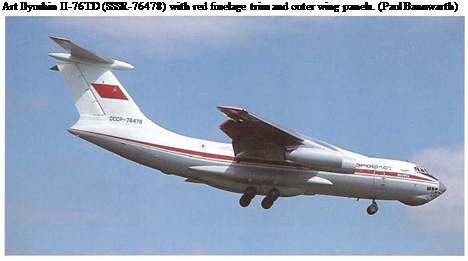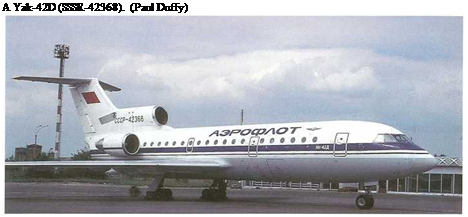Ilyushin 11-76
50 TONS ■ 750km/h (470mph)
Soloviev D-30KP (4 x 12,000kg st, 26,4551b st) ■ MTOW 170,000kg (375,0001b) ■ Normal Range 3,650km (2,190mi)
The Second Big Freighter
The Antonov An-22 (see page 67) had captured the aviation world’s attention during the mid – 1960s, with its impressive size and the ability to carry 80 tons of cargo. When the Ilyushin 11-76 made its maiden flight at Moscow’s almost-downtown Khodinka airfield on 25 March 1971, it did not attract quite as much publicity, possibly because it did not beat any records in sheer size. Its all-up weight was about 44 tons less than the big Antonov’s, but it was nevertheless just as impressive, and appears to have been more popular with the operators, as far more Il-76s are to be seen the length and breadth of Russia and the former Soviet republics than its larger rival.
The big freighter went into series production for civil use as the 11-76T in 1975, and deliveries began to Aeroflot in 1976. Like the Antonov series of heavy lifters, the 11-76 had a pronounced anhedral wing, and — also like the An-22 (and the Lockheed C-141) — it had superb short-field and rough-field performance, thanks to the manner in which the total weight of the aircraft was distributed among the multiple-wheeled landing gear. Sixteen main wheels are mounted in fuselage pods, and are arranged in banks of tandem axles, four abreast on each side. The 11-76 can carry 40 tons, but habitually carries loads of around 20 tons over ranges of about 7,000km (4,000mi), i. e. nonstop from Moscow to Khabarovsk or Yakutsk. It can moreover make this performance to and from airfields with runways about 1,700 meters (one mile) in length.
Universal Popularity
Such versatility makes it almost indispensable for long-range cargo operations, especially as its 24-meter (almost 80ft) – long cargo hold is more than 3m (10ft) high and wide. Every main traffic center of Aeroflot, and especially the big air traffic centers in Siberia, enjoys regular air cargo connections with all corners of the system, from Murmansk to Vladivostok; and it is especially welcomed at Yakutsk, which is not served by rail, and where road and river traffic is burdensome and restricted to a short season. A longer range variant, the I1-76TD, went into production in the early 1980s.

 The Ilyushin Il-76’s finest hour, however, was almost certainly when it made a flight to Antarctica in 1986, and repeated the performance in 1987 and 1989. For this operation, it was able to alight on packed snow and on slick ice, both challenges to airmanship and aircraft integrity. These remarkable long-distance heavy-lift sorties are described on page 71.
The Ilyushin Il-76’s finest hour, however, was almost certainly when it made a flight to Antarctica in 1986, and repeated the performance in 1987 and 1989. For this operation, it was able to alight on packed snow and on slick ice, both challenges to airmanship and aircraft integrity. These remarkable long-distance heavy-lift sorties are described on page 71.
Lotarev P-36 (3 x 6,500kg st, 14,330ib st) ■ MTOW 56,500kg (124,5601b) ■ Normal Range 2,200km (l,320mi)
Early Promise
Soviet aircraft that traditionally attracted attention in the West, notably at such shop windows as the Paris Air Show, did so because they were bigger or faster than had ever been seen before. The Yakovlev Yak-42 was different. When it first flew on 7 March 1975 (as a 100-seater), and when Aeroflot ordered 200 of the new trijet in June 1977, the world sat up and took notice; because at last, it was suspected, the Soviet Union had produced an airliner that could compare with equivalent western types, not only in performance, but also in operating, efficiency.
Although Aeroflot discussed the possibility of the 120-seat Yak-42 being a replacement for a wide range of obsolescent types, from the Antonov An-24 to the Ilyushin 11-18, it was directed mainly to supersede the Tupolev Tu-134 80-seat twin. Certainly, the figures look promising. The 120-seat six-abreast Yak-42 was only five tons heavier than the four-abreast Tu-134, and was not much bigger. It needed only two crew members, instead of the three or four of the Tupolev. It had good short-field performance, could use rough airstrips, and had the additional features of built-in airstairs and baggage racks on each side of the door entrances. It seemed to fit halfway between the Tupolev Tu-134 twin and the Tupolev Tu-154 trijet, and a great future seemed assured.
The Pace Slackens
The Yakovlev Yak-42 entered service with Aeroflot in November 1980, on routes such as Moscow-Kostroma and Leningrad-Helsinki. Later on, it was introduced as a back-up to the heavy air corridor traffic to the Caucasus; and it operated to Prague, both from Kiev and Lvov.
The introduction of the Yak-42 was marred by many technical problems and, following an in-flight structural failure of the tailplane, the type was withdrawn from service in the early 1980s. After more than 2,300 design changes, it re-entered Aeroflot service in the late 1980s and quickly gained an impressive reputation for reliability, efficiency, and economy.


 |
In 1990, the longer range 120-seat Yak-42D was introduced, and is probably one of the most comfortable Russian-built aircraft in the Aeroflot fleet. By June 1992, 115 Yak-42s and 50 Yak – 42Ds had been delivered to Aeroflot.










